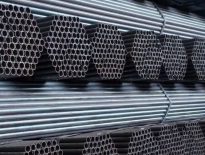A boiler with a high-pressure water tube is a type of boiler in which water circulates in tubes externally heated by the gas. Inside the furnace, fuel is burned, producing hot gas that heats water in the tubes to produce steam. Carbon steels display modest tolerance to corrosion and equal strength up to 1000F. Nevertheless, the vulnerability of graphitization must be taken into account in their use over 800F. graphitization was not a major problem in thicknesses used in boiler tubing. However, it is not advised to use a large segment pipe over 800F.
Carbon Steel Overview
Steels containing only carbon are known as carbon steels, as the basic alloying factor. These steels can also contain up to 1.2% manganese, and 0.4% silicon. In addition to ‘ impurities ‘ such as phosphorous and sulfur, residual elements such as nickel, chromium, aluminum, molybdenum, and copper, which are naturally extracted from raw materials, may be found in small quantities.
Carbon Steel Boiler Tubes
The Carbon steel boiler tubes don’t start to work until the burning of wood, fuel, oil or flammable gas, and the heat generated by burning results in water heating. The distinction could be a measure of the energy a system creates. Unlike boilers, steam turbines give higher pressures. An atomic reactor, apart from gas, can provide electricity too. The motor is driven with energy because of the water which switches to the steam. Even before the expression “Steam Turbines” was used, the engine of the train was called boilers. In the bigger engine called steam turbines, Carbon steel boilers today are just one part. Boiler tubes are manufactured in different sizes and configurations that depend on the fuel’s characteristics, the specified heating yield and the necessary emission controls. A number of boilers are only equipped for heating water, while others are supposed to provide steam. There are 2 types of conventional steam boiler: fire-tube heater and water-tube heater.
Fire-tube heater is anything but hard to set up and run. A fire-tube heater is used on steam trains. Usually, water-tube heater is attached to vessels and lines of factories. For starters, boats use the steam supplied for various procedures such as heating, sanitation etc. Fire-tube boilers have straight tubes mounted inside a water-filled outer shell in a row. The main purpose of this system is to allow such tubes to pass through the hot flammable gases. Boilers with fire-tube are split into three classes. The capacity of Water tube boilers to produce superheated steam renders such boilers particularly attractive for applications involving hot, high-pressure, high-energy steam like the generation of steam turbine electricity. Water circulates inside the tubes in water-tube boilers and is heated externally by furnace-generated hot gasses. Hot gas passes through one or many tubes with fire-tube boilers which heat up the water around them through thermal conduction. ASME SA179 Boiler Tubing is the lower carbon version; it has up to 0.25 % of carbon content. This boiler is also called a mild grade. The boilers are ductile and stronger with low wear and tear.
Applications
Pressure trolls to regulate boiler vapor pressure. In general, boilers have 2 or 3 pressure trolls: a manual reset pressure trolley, which acts as a safety device by setting the upper limit of the steam pressure, the working pressure trolley, which controls when the boiler fires to sustain the pressure, and a modulating pressure trolley for boilers fitted with a modulating burner.
Carbon steel tubing is also used in safety valves. It is used for relieving pressure and preventing possible boiler explosion. These are also used as markers of the Water Level. They show the user the amount of fluid in the boiler, also known as a glass of sight, water gauze or water column

